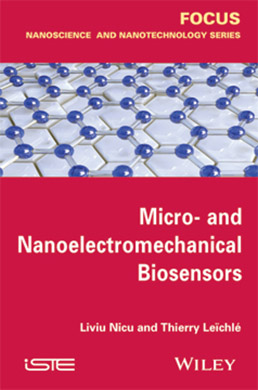
In a world where the biological threat may take multiple forms associated with environmental, health or defense issues, the need for versatile biosensing platforms has become a vital concern. The aim of a biosensor is to identify and quantify one or several biological species. No matter the type of biological species targeted by a biosensor, the fundamental requirements for a successful biosensing process are always the same: best specificity, sensitivity, fastest time of analysis and for specific applications, e.g. point-of-care analysis, portability.
With a technological context where a plethora of configurations seem to meet some or all of these requirements, it is important to understand the role that micromechanics can play in the provision of new classes of biosensors for applications requiring highly sensitive, portable (thus integrated and low-power consumption) and label-free sensing platforms. The authors of this book shed light upon the field of microelectromechanical system (MEMS) based biosensors and provide a contemporary snapshot of the miniaturized biosensors landscape without neglecting the seminal references or products where needed.
The chapters cover the main transduction methods for biosensing amendable to miniaturization, the different types of bioreceptors and the associated grafting methods that confer biosensitivity to solid surfaces, the technological tools available to achieve the specific and localized biofunctionalization of the sensor surface, and the advantages offered by further device miniaturization from MEMS to nanoelectromechanical (NEMS) biosensors in terms of performances and integration capabilities, along with the associated challenges inherent to the realization of nanoscale biosensors. The book concludes by raising an important issue: how can we compare the performances of biosensing platforms, and how should we choose the most appropriate one for a given application? The final chapter strives to answer this crucial question in order to provide the means to assess the interest and advantages of MEMS biosensors.
1. Transduction Techniques for Miniaturized Biosensors.
2. Bioreceptors and Grafting Methods.
3. Patterning Techniques for the Biofunctionalization of MEMS.
4. From MEMS to NEMS Biosensors.
5. Comparing Performances of Biosensors: Impossible Mission?
Liviu Nicu is a CNRS researcher at the Laboratory for Analysis and Architecture of Systems (LAAS) in Toulouse, France where he currently develops resonant bio (chemical) sensors.
Thierry Leichle is a CNRS researcher at the Laboratory for Analysis and Architecture of Systems (LAAS) in Toulouse, France. His research interests focus on the use of micro- and nanotechnologies for biosensing applications.